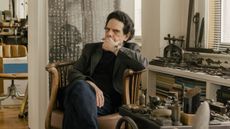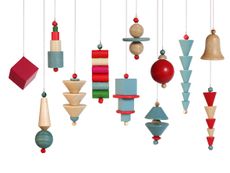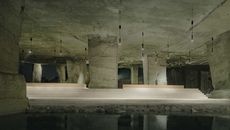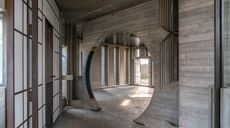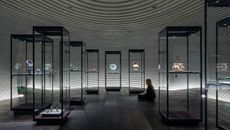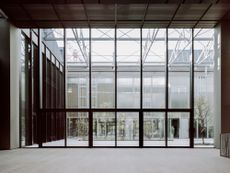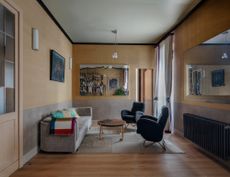Italian beauty: a new show celebrates the career of Mario Bellini
- (opens in new tab)
- (opens in new tab)
- (opens in new tab)
- Sign up to our newsletter Newsletter
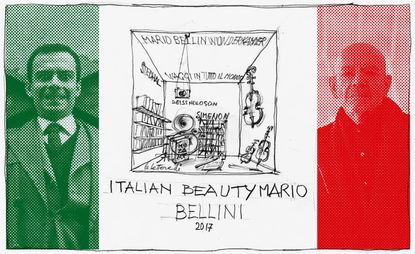
Mario Bellini’s long and distinguished career spans design brands and counter-trends. As a designer who grew up in the austerity of post-war Italy, then began his career at the height of Pop and the Italian industrial boom, Bellini would be forgiven for an unrooted eclecticism. Yet what defines his work (still in progress) is a commitment to a sense of place and a sense of beauty, but bound up with a functional rigour that transcends shifts in the way we interact with places and things.
As his ‘Italian Beauty’ exhibition opens at the Milan Triennale, it’s perhaps time to take stock and celebrate a lifetime in design. This is not a retrospective, according to Bellini, but a ‘prospective’, and the 1,200 sq m show takes you through a career spanning six decades. The space is a stage for Bellini’s many and varied products, from chairs to typewriters to lamps, with seating areas placed before vast screens to give an impressive, immersive insight into a suite of his studio’s best-known buildings.

Bellini can lay claim to being one of the progenitors of modern technological style, together with other precursors like Dieter Rams and Jacob Jensen. During his long and fruitful collaboration with Olivetti, he reshaped the office landscape into a playful, colourful space that banished the tans and greys of the dominant IBM approach. And where Rams brought a Northern European austerity to consumer design, Bellini has always headed in a more humanist, playful direction.
‘Italian Beauty’ begins with a vast cabinet of curiosities containing objects and memorabilia that have inspired Bellini, including pieces by Gio Ponti and Issey Miyake – historical fragments of memory, art and literature. ‘I’ve designed furniture, objects, machines, buildings,’ Bellini says. ‘So to design an exhibition about myself is to go back to something I did at the very start of my career. But it’s also more special and challenging.’

An archival advertisement for Olivetti typewriters
Bellini was born in 1935. Exceptionally talented at sketching from a young age, thanks to the encouragement of a grandfather, he spent five years studying at Milan’s polytechnic, graduating in 1959 and beginning his career as primarily an exhibition and product designer. In Olivetti, he found a client that shared his love of detail. In Bellini, Olivetti found a designer who could simplify its increasingly complex wares and give them a seductive yet friendly appearance. Their collaborations included the legendary ‘Programma 101’ of 1964, an impressive calculating machine that many consider to be the first desktop computer.
The Olivetti partnership made Bellini a major force in industrial design, whose works were collected by MoMA and who was eagerly sought by other clients, such as Cassina (for whom he designed showrooms), Vitra and B&B Italia. His guiding principle is to combine functionality with finesse – or ‘dreaming and doing’, as he describes what he learnt in his student days. ‘You have to be talented to answer needs and yet end up with beauty,’ he says. ‘Needs, functions, materials, costs and rules all have to come together. But beauty also comes too. To create a simple object you need grace and poetic beauty.’

A photograph from Bellini's US road trip in 1972
Throughout his career, Bellini has always looked further afield, drawing inspiration from other cultures and approaches, including the design communities in Japan and Northern Europe. He has also had a long and favourable relationship with the US, a country he explored in a 1972 road trip after his participation in a MoMA exhibition on the Italian design scene (see W*199).
In the late 1980s, Bellini was a pioneering editor of Domus at a time of a great renaissance in Italian product design and architecture, and his profile was buoyed by a 1987 MoMA retrospective. His career has also spanned social and technological change, but he has never lost sight of the emotional component of design. ‘Whenever we design something we look for beauty – it’s a very delicate thing that connects you to the world through your senses. Beauty is a way of communicating meaning – something that connects with you and moves you.’ Bellini is now an elder statesman of modern design, but his work continues to surprise and delight.

The exhibition begins with a cabinet of curiosities full of Bellini’s designs, and continues in the same vein, packed with furniture, technology, branding and architecture.

The landmark exhibition stretches across 1,200 sq m guiding visitors through Bellini’s fascinating six decade career

The landmark exhibition stretches across 1,200 sq m guiding visitors through Bellini’s fascinating six decade career

Bellini’s designs reshaped the office landscape. He designed this furniture range, ’Pianeta Ufficio’, for Marcatré Spa in 1974

Installation view of Bellini’s 1987 exhibition at the MoMA in New York

Bellini at his Milan Convention Centre, completed in 2012. Part of the 15,000 sq m silvery canopy roof tapers to the ground behind him.

The Milan Convention Centre at night

The ’Teneride’ chair for Cassina, 1970.

Many consider the ‘Programma 101’ – an impressive calculating machine launched in 1964 by Olivetti – as the first desktop computer

Mario Bellini’s chair designs on display at ’Italian Beauty’.

Located in North Carolinia, the Natuzzi headquarters was built between 1996 and 1998.

The exhibition and congress centre Villa Erba in Como, Italy, was built between 1986-1990.

Sketch for the Centro Interculturale della Città di Torino

Bellini was a pioneering editor of Domus in the late 1980s, the time of a great renaissance in Italian product design and architecture

The classic Brionvega range of electronics

Bellini describes the ’Italian Beauty’ exhibition as a ‘prospective’ instead of a ‘retrospective’.

’Divisumma 18’ electronic printing calculator, 1973

Render of the forthcoming the Qatar Fifa World Champions stadium

Cassina’s ’Cab 412’ lounge chair, launched in 1977

The ’Opera Tonda’ table from Meritalia

The playful display of the new exhibition communicates the essence of Bellini’s bold and progressive style. The art work for the exhibition poster, banner and catalogue cover have been designed by designer Leonardo Sonnoli.
INFORMATION
‘Italian Beauty’, curated by Deyan Sudjic, is on view until 19 March. For more information, visit the Milan Triennale website (opens in new tab)
Jonathan Bell has written for Wallpaper* magazine since 1999, covering everything from architecture and transport design to books, tech and graphic design. He is now the magazine’s Transport and Technology Editor. Jonathan has written and edited 15 books, including Concept Car Design, 21st Century House, and The New Modern House. He is also the host of Wallpaper’s first podcast.
-
 Remembering New York artist Daniel Brush, 1947 – 2022
Remembering New York artist Daniel Brush, 1947 – 2022In tribute to Daniel Brush, who has died aged 75, we revisit this 2020 Wallpaper* profile of the elusive New York artist by jewellery historian Vivienne Becker, who unravelled the secrets of his singular designs for her book, ‘Daniel Brush: Jewels Sculpture’
By Vivienne Becker • Published
-
 Interior design books championing shelf love
Interior design books championing shelf loveWelcome to the Wallpaper* guide of the best interior design books published in 2022 and beyond – a collection of riveting visual tomes to feed creative innovation, inspiration and imagination
By Rosa Bertoli • Published
-
 Christmas decorations from leading creatives and design brands
Christmas decorations from leading creatives and design brandsOur edit of contemporary Christmas decorations ranges from architect-designed festive ornaments to Christmas baubles by leading creatives
By Rosa Bertoli • Published
-
 Step inside the dramatic Cava Arcari by David Chipperfield
Step inside the dramatic Cava Arcari by David ChipperfieldCava Arcari by David Chipperfield reimagines a series of caves outside Vicenza as a multifunctional event space
By Ellie Stathaki • Published
-
 Rinascente is reborn in Rome’s Piazza Fiume courtesy of design studio 2050+
Rinascente is reborn in Rome’s Piazza Fiume courtesy of design studio 2050+Rinascente in Piazza Fiume, Rome gets a makeover by Milan-based interdisciplinary design agency 2050+
By David Plaisant • Published
-
 This Sicilian villa brings contemporary architecture to the foot of Mount Etna
This Sicilian villa brings contemporary architecture to the foot of Mount EtnaL House is a modern Sicilian villa in perfect sync with its surroundings, designed by London-based architecture practice Transit Studio
By Ellie Stathaki • Published
-
 Take the ultimate Carlo Scarpa tour of Venice
Take the ultimate Carlo Scarpa tour of VeniceA Carlo Scarpa tour to end all tours; join our survey of modernist buildings by the Italian midcentury master in and around Venice
By Natasha Levy • Last updated
-
 Etruscan Galleries at Fondazione Luigi Rovati by Mario Cucinella just flow
Etruscan Galleries at Fondazione Luigi Rovati by Mario Cucinella just flowIn Milan, the Etruscan Galleries at the Fondazione Luigi Rovati, designed by architect Mario Cucinella, open to the public
By Ellie Stathaki • Last updated
-
 This historical Florentine villa is given a contemporary rethink
This historical Florentine villa is given a contemporary rethinkDanish design brand Frama and filmmaker Albert Moya have worked together to update the Villa Medicea di Marignolle in Italy
By Hannah Silver • Last updated
-
 Minimalism and transparency rule at Luxottica’s Digital Factory in Milan
Minimalism and transparency rule at Luxottica’s Digital Factory in MilanLuxottica's Digital Factory by Milan-based architects Park Associati is the latest addition to the city's via Tortona neighbourhood
By Ellie Stathaki • Last updated
-
 Luca Guadagnino’s Milan apartment design is an ode to timelessness
Luca Guadagnino’s Milan apartment design is an ode to timelessnessA nostalgia-infused Milanese pad by Studio Luca Guadagnino has real screen presence
By Laura Rysman • Last updated
